What heating is better for a private house: 3 effective
One of the most important engineering networks of the home is a system that provides residents with heat. Without high-quality heating about any comfort and comfort out of the question. Therefore, each owner of his own home wants to know what kind of heating to make in a private house, especially if he builds it with his own hands. Read about the most popular options, their advantages, disadvantages and features.

Criteria for choosing a climate system
There is no universal answer to the question of how best to make heating in a private house. It all depends on local conditions, individual preferences, the cost and availability of various heat transfer fluids in your area, as well as other factors.
However, there is a small instruction, following the rules of which you will be able to choose for yourself the best option, so that later do not regret about the decision.
So, the best heating for a private house should meet the following criteria:
- The power of the climate network should be sufficient to provide all the rooms of the cottage with thermal energy. In addition, it is desirable that the minimum amount of energy sources be used to maintain its work.
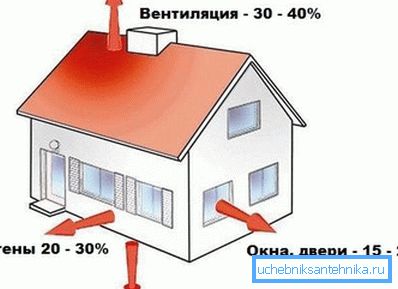
Tip! When choosing a particular type of heating system, ask what is the price of the fuel used by the boiler. Perhaps operating costs will be too high, in this regard, it is advisable to stop at another option.
- Heating should function independently, if possible without human intervention.. Ideal - turned on, set up modes of operation and forgot. Therefore, choosing what kind of heating for the house is better, give preference to automated systems.
- Capital investments in the climatic equipment should not be too high. For example, one of the most economical systems is a heat pump, but the cost of designing such heating can sometimes exceed the price you paid for a small dacha.
- Installation of the selected heating scheme, as well as its maintenance, should not be too complicated. Ideally, it is desirable to choose a type of heating that you can install, start up and repair yourself.
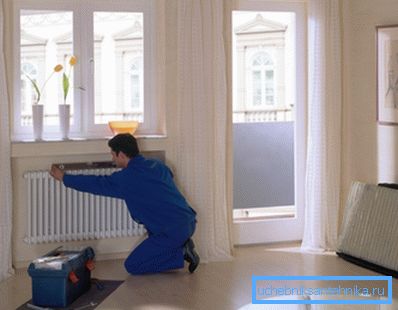
Country cottage heating schemes
After reviewing the requirements, let's look at what are the heating systems of a private house, what are their strengths and weaknesses. For convenience, all the advantages and disadvantages of various equipment are presented in tabular form.
Scheme 1. Air
It is possible to heat the country house with the help of a ventilation system. Thus, a comfortable microclimate is often maintained in industrial premises and commercial buildings.
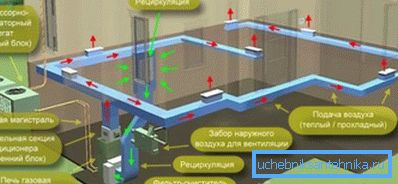
The scheme of operation of such an installation is extremely simple: in a special device - a heater or recuperator - the air masses injected from the street get warm to the desired temperature, after which they are distributed through specially designed ducts to all the rooms in the house.
The advantages and disadvantages of the described system are as follows:
| pros | Minuses |
| The heating system operates without a heat transfer fluid circulating in pipes and radiators. Consequently, you are initially protected from leaks, freezing, airing and other similar troubles. | The equipment used to design the air heating system is quite expensive. In addition, installation of ventilation channels will be required. Be prepared for significant material costs. |
| Air heating not only heats the air, but also stabilizes its humidity, which allows you to create a more comfortable microclimate in the house. | For the installation of a massive and dimensional heat generator with fans, which is the central element of the system, you need to allocate a separate room. |
| An air heating system can be designed to not only heat the air, but also cool it if necessary, as well as clean the rooms from unpleasant odor, smoke, and so on. | Air heating works on the principle of constant air circulation. The latter, moving around the room, raises the dust in it. To avoid this, it is necessary to provide for the installation of filters. |
| This engineering network has a fairly high efficiency - the efficiency of the equipment reaches 90%. | The ventilation system with heated air during operation produces a noise that can cause inconvenience to the inhabitants of the house. |
| Heating of rooms using warm air has low inertia. As soon as you turn on the heating installation, it becomes noticeably warmer in the rooms, which is very important for houses and cottages that are not intended for year-round living. | Air heating has a relatively low degree of heat transfer. Therefore, in order to maintain the desired air temperature, it is necessary to pump large volumes of air, which takes electricity. |
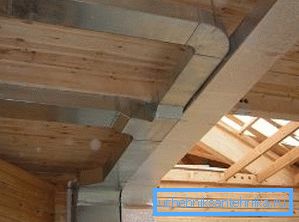
According to the statistics collected, this heating method is used in about a quarter of the houses under construction. Air heating is expensive to install, but it will be an excellent choice for small cottages, in which you are going to visit only from time to time.
Scheme 2. Electric
Another popular option is the use of electricity. It can be convectors, replacing the usual radiators, or infrared films installed on the ceiling.

Consider the positive and negative aspects of the use of such systems.
| pros | Minuses |
| Heating with electricity is the most environmentally friendly. When operating the equipment, no harmful combustion products are released into the environment. Even in the event of a breakdown of the heating device, no harmful substances pollute the environment. | Electricity as an energy carrier is quite expensive. Among all the varieties of existing fuels, electricity is the most expensive. Therefore, such a system is not suitable for heating a large area of the house, since the cost of paying for services will be too high. |
| Electric heaters are quite simple. They do not require periodic maintenance and special handling during operation. | Electric heaters in the course of their work burn oxygen and lower the level of humidity in the room. Therefore, during the operation of such heating equipment, it is necessary to organize additional ventilation. |
| Installing electric heating in the house is quite simple. You just need to place in the appropriate places a sufficient number of convectors and connect them to electricity. About any installation of pipes we are not talking. | The climate system is completely dependent on external engineering networks. A broken electrical wire, which often happens in rural areas, will leave you completely without heat. |
| Electric heaters can be mounted on a wall or mounted on legs. In the latter case, you have the opportunity to freely choose their place of installation, creating for themselves the most comfortable microclimate. | Electric climatic equipment consumes a large amount of electricity. Therefore, before installing such a system, you must make sure that the wiring in the house and the main power lines are designed to supply such a volume of electricity. |
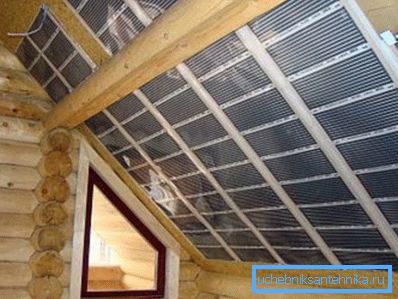
An analysis of current trends in the climatic equipment market shows that electric heating has good trends towards development. New, more economical electric heaters appear, and modern heat-insulating materials make it possible to reduce unproductive heat consumption to a minimum.

But now it is possible to recommend electric heating only for small houses, which are used as temporary housing.
Tip! Electric heating can be used as backup or additional. For example, it is possible to arrange heating of rooms in the house with the help of a solid fuel boiler, after which a comfortable temperature will be maintained by convectors or infrared emitters.
Scheme 3. Water
The heating system with a liquid coolant is one of the most common. The scheme of its work is as follows: the liquid heated by the boiler (water or special antifreeze) through the laid pipes is supplied to the installed radiators, where it gives thermal energy to the air in the room.
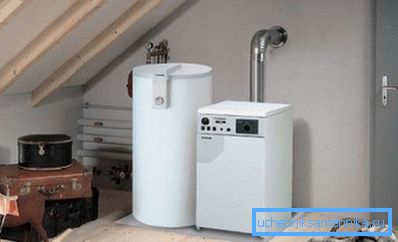
The heat source is a heating unit, which can operate on the following types of fuel:
- liquid - diesel or used engine oil;
- solid - firewood, coal, fuel briquettes or pellets of biofuel;
- gaseous - main or liquefied gas;
- Electricity - in this case, in contrast to the one described above, a boiler is used, not convectors or infrared heaters.

Its advantages and disadvantages are as follows:
| pros | Minuses |
| Water is almost the cheapest, generally accessible and safe coolant, the use of which does not harm the environment and human health. | To maintain high efficiency, it is necessary to constantly clean heating radiators, since dust interferes with normal heat transfer. |
| The amount of coolant poured into a closed heating system does not decrease (especially if a closed expansion tank is used), therefore, it is not necessary to top up the purchased antifreeze. | The system has a large inertia. After switching on, it should take quite a long time before the temperature in the house rises to the desired level. To speed up the process will help the circulation pump, which increases the rate of flow of water. |
| Water heating system with a boiler can be installed completely independently. The exception is gas boilers, the installation of which is made by certified workers after obtaining the appropriate permit. | Metal elements of the heating system are subject to corrosion, as a result of which the climate network can leak. To protect yourself from this trouble is simple: you need to use plastic pipes. |
| The use of multiple circuits or radial heating system allows you to very accurately control the temperature in individual areas of the house. | Water poured into pipes must be cleaned from dissolved minerals, acids and alkalis that may damage the heating equipment. |
| The presence of a double-circuit heating boiler makes it possible to provide residents of the house not only with heat, but also with hot water for domestic needs, eliminating the need to purchase additional expensive water-heating equipment. | The water heating system is not suitable for homes where people are not expected to live year-round, since after turning off the heating boiler, the liquid in the pipes and radiators may freeze and cause the equipment to become unusable. |
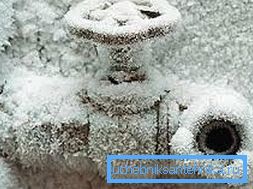
Water heating system is most often used to heat private homes. And if the heating medium is heated by a gas boiler, then it is also the most economical, efficient and ergonomic.
Tips for organizing water heating
To make the heating system of a private house as efficient as possible, it is recommended to combine two heating schemes:
- use radiators with aluminum heat exchangers (even better - bimetallic), with which you can organize the most efficient and rapid heating of rooms;
- install in the house a system of water heated floors, which will maintain a comfortable temperature with minimal energy consumption.
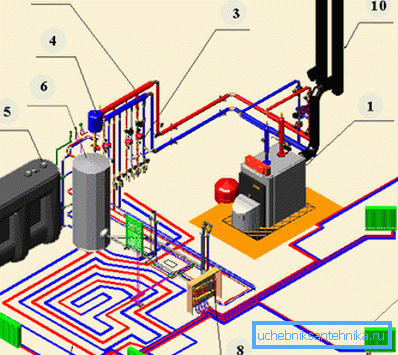
The fact is that radiators heat the air, which then rises to the ceiling. Therefore, to ensure the heating of air masses at the floor level to a comfortable temperature, which is considered to be + 18aboutC, it is necessary that this indicator for the whole room be at least + 25aboutC, which increases the cost of heating. When using the system of warm floors, this deficiency can be avoided.
But without radiators can not do. They reduce the inertia of the system. By organizing the convection of air flow, these elements of the heating network warm up the air faster.
Tip! It is advisable to make separate heating circuits for batteries and floor heating systems. Then you can adjust the temperature readings more accurately, achieving greater comfort and saving coolants.
Conclusion
After analyzing the advantages and disadvantages of each of the proposed schemes for your attention, you can decide for yourself what kind of heating is better for the house. About other engineering networks that provide comfort to the inhabitants of the house, you can learn from the video posted in this article.